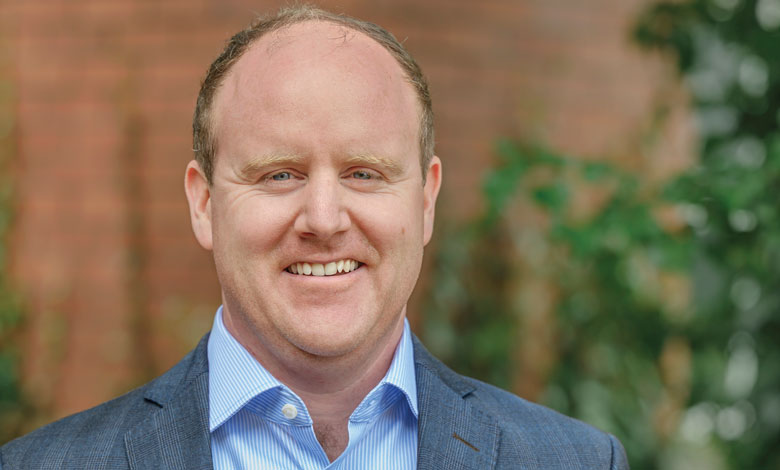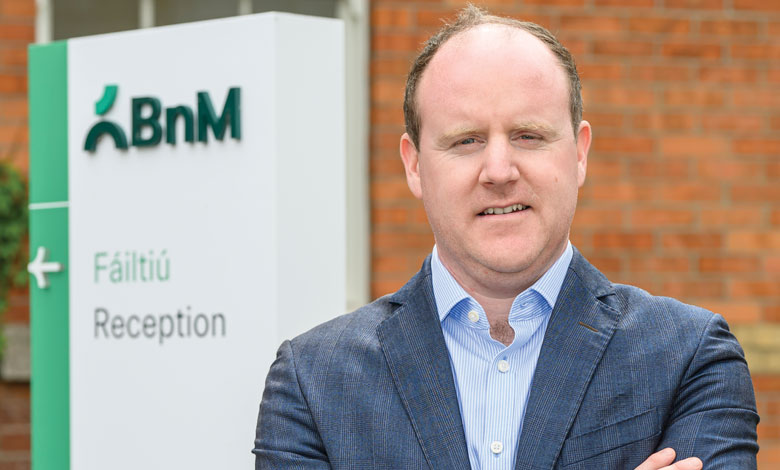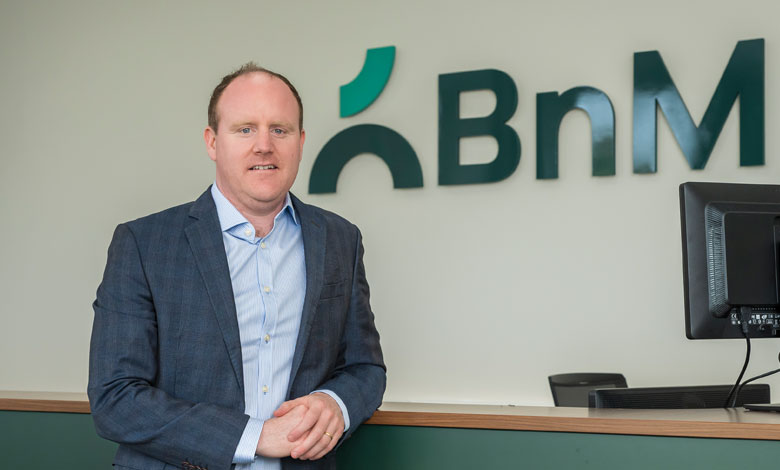
Minister Caoimhe Archibald MLA: Driving the energy transition
15th October 2025
On the cusp of an energy revolution
16th October 2025Powering Ireland’s energy revolution BnM’s Brendan Kelly

Brendan Kelly, Head of Commercial at BnM, talks to Owen McQuade about the company’s renewable energy projects, totalling 1GW delivered to date, and its plans for a further 5GW, including energy parks to deliver on the State’s decarbonisation, energy security, and industrial development ambitions.
BnM, the trading name for Bord na Móna PLC, has supported the energy security of the State for over 90 years. Its transformation has been significant over the last decade, transitioning from one of the most carbon intensive companies in the State, responsible for around 10 million tonnes of CO2 in the early 2000s, to a renewable energy company with close to zero CO2 emissions.
“We have shifted our focus entirely to renewable energy and renewable energy infrastructure. We are accelerating the delivery of energy infrastructure to support the energy security of the State in the form of renewables, generation, and supporting grid expansion,” explains Kelly.
“The company has undergone a remarkable transformation over the last five to ten years. Our assets have just surpassed 1GW of generation under management, which translates into 2 TWh of low carbon electricity. That is 15-20 per cent of low carbon electricity production in Ireland. The company also has a significant pipeline of development projects totalling 5GW of a mixed portfolio of technologies,” says Kelly.
Opportunity
Kelly observes that we are in the middle of the fourth industrial revolution, which is being driven by three megatrends: decarbonisation, electrification, and artificial intelligence (AI). “AI promises to change how the economy functions over the next 10 to 20 years; how we go about our lives and run our businesses on a daily basis. The levels of investment in AI by the technology giants is staggering with up to $500 billion this year [2025] alone; that is equivalent to the total GDP of countries like Denmark or South Africa.”
BnM also sees itself as a major player in supporting the State’s industrial policy. “Ireland is well positioned in that the biggest tech companies in the world are located here and we were early adopters in accommodating data centre growth in the 2010s. Ireland has a strong position to capitalise on the next phase of growth in this important sector of the world economy and BnM is supporting that.”
Electrification of the economy has accelerated the electrification of homes and businesses over the last five years, as Ireland looks to achieve its targets of 945,000 EVs and 600,000 heat pumps by 2030.
“This is having a huge impact on Ireland’s energy security as we wean ourselves off fossil fuels, instead generating indigenous renewable electricity. Consider a typical country town the size of Tullamore or Newbridge. If all homes and businesses in these towns install an EV changing point and a heat pump, that will have a huge impact on total and peak electricity demand. To enable that, we need to build more indigenous energy to ensure it is carbon free, and we need to build out the grid significantly.”
BnM has been a significant player in the drive to decarbonise the Irish electricity system. It is active across the renewable electricity sector with a pipeline consisting of 2.5GW of onshore wind, 0.5GW of solar, 1GW of ‘Flextech’, which is a combination of energy storage, flexible grid technologies and gas-fired generation.
Included in this portfolio are a number of ‘mega projects’ such as a 700MW Derrygreenagh power plant in County Offaly, one of the largest power plants in the planning system, and the Ballydermot wind farm which will be the largest standalone wind farm in the country at over 300MW. Delivery of these and the associated grid infrastructure will have a massive impact on the wider system and the wider regional economies.
In addition to enhancing energy security, this will facilitate new industrial demand to connect to the system. It is also developing 1GW of offshore wind energy in a joint venture with offshore wind developer Ocean Winds, which is itself a joint venture between Portugal’s EDP Renewables and French energy company Engie.
Challenges
BnM’s transition mirrors the State’s ambition to deliver a carbon neutral electricity system. “It is relatively simple when broken down into its four constituent parts: build generation capacity; balance and back up all the various forms of intermittent generation; enhance and expand electricity infrastructure across the island; and grow the underlying electricity demand base, through electrification and industrial demand growth,” explains Kelly.
“Securing the generation, grid capacity, and demand that we need, hinges on the delivery of grid infrastructure. BnM does not want to sit on the sidelines when it comes to the delivery of grid infrastructure, and we want to play a big role in that.”
In this respect, BnM owns almost 700km of narrow-gauge railway track interconnecting large portions of the midlands that were previously used to transport peat to the power stations and briquetting factories.
At one stage, BnM was the largest private rail operator in Europe. That infrastructure is no longer in use and leaves up to 80m wide corridors across the Midlands. As a state-owned commercial entity, BnM wants to play a role in facilitating infrastructure development in those corridors and is working with EirGrid and other state agencies to do so. In turn, Kelly asserts that this will unlock the next wave of industrial development.
“Achieving our ambitions begins and ends with electricity infrastructure delivery. Ireland has not delivered this infrastructure at the required level over the last decade. We adopted a fantastic model for delivery in the 2010s in counties Cork and Kerry, when EirGrid successfully delivered four 220kV cluster substations and hubs. Windfarms were able to interpret the locational signals and connect into the grid, helping us meet our 2020 targets. A similar model is now needed to help renewable energy connections and to connect demand side customers.”
Regulation
On regulation, Kelly says that there are “some green shoots in terms of enabling the delivery of new infrastructure, not least the latest announcement of €14 billion grid investment programme in PR6. Speed is essential to deliver the infrastructure needed and we think that a lot of this can be done within the existing regulatory constructs”.
Private wires will help accelerate the decarbonisation of industrial plants. For example, a cement manufacturing plant could build and connect to a solar farm adjacent to its site. It will also catalyse the development of green hydrogen production in Ireland, again areas BnM are active in with a pilot project under commercial development at Mountlucas Wind farm.
BnM’s landbank sits in the middle of the island with the 400kV and 220KV high voltage infrastructure already overhead. “We do not need to build long lengths of infrastructure, we already have strategic infrastructure in the right place to attract generation demand. That is central to our ‘energy park’ concept. In 2024, we announced a partnership with AWS in which it would become the first tenant on one of these energy parks. The concept is very simple; tap into the high voltage infrastructure that crosses our land and connect large-scale renewable energy generation and large-scale demand, thereby ensuring a sustainable industrial development model.
“The challenge for renewable electricity generation delivery comes down to the capacity of the grid. Dispatch down has increased 30 per cent year-on-year over the last few years. That is a challenge around the certainty of the output from your projects which in turn impacts on the financing of those projects. The TSO [transmission system operator] can do some things relatively quickly to unlock more capacity. Relaxation of planning and operational policies or introducing smart technologies such as dynamic line rating or power flow controllers will get more capacity out of existing lines.”
On firm generation, Ireland has struggled over the past few years to meet growing demand. “It is very difficult through existing capacity mechanisms to drop a pin and say this is how much generation capacity we need in 2030. We should therefore look at a five- to 10-year window and determine how much firm generation capacity we need over that period and then let the projects come in and deliver certainty. In addition, our capacity planning should also go hand-in-hand with our industrial policy. If we are trying to attract semiconductor plants or new data centres, then we need to grow firm generation capacity to cover periods when the intermittent renewables are not available. They will run more and more infrequently, but are absolutely needed for security of supply.”
Supply chain challenges
Discussing the global race for transformers, switchgear, and turbines, Kelly comments on the challenge of securing supply of critical items for future investment. “Both the Dutch and German TSOs have locked up order books for HVDC [High Voltage Direct Current] equipment from critical suppliers for a period of time. That is what other countries are doing and we need to look at securing long-lead time items that are critical to Ireland’s energy transition. It is anticipatory investment, but you never look back and say ‘I over-built that transmission line’ or ‘that transformer was too large’. It is our job as developers and investors to max out that infrastructure.”
“It sometimes feels that things are moving slowly but when you look back over the last 30 years Ireland has made tremendous strides from being heavily fossil fuel dependent to now having a clear pathway to net zero.”
Social license
On the challenges of the planning system Kelly says that things have improved over the last 12 to 18 months as more projects are now coming through the system. However, judicial reviews are still a challenge and, he argues, should be dealt with more quickly as they lead to projects being delayed for considerable periods of time, which only has a knock on impact on time and cost.
“Social license is critically important,” he acknowledges, adding: “It is important to give back to communities when investing in energy infrastructure. BnM has long been an advocate of community benefit schemes investing €1.4 million in the last year alone. When Mountlucas Wind Farm was built in 2014 the wind farm site was made accessible for walking and a weekly Park Run. Schools are regular visitors to the Mountlucas visitor centre and BnM, in conjunction with ESB, invested €3 million in its visitor centre at Oweninny wind farm in County Mayo.
We are also working with Fáilte Ireland on ‘Project Connect’, building over 60km of cycle trails and walkways on our land across the Midlands. This active travel infrastructure will link up with existing greenways and blueways and again demonstrates our commitment to creating a better environment for communities.”
Kelly regards BnM’s remit first and foremost as delivering on the country’s Energy Security and Decarbonisation mandates. “Offaly is one of the largest counties producing renewable energy and now is acting as a magnet for large scale Foreign Direct Investment (FDI). If we can work to attract industrial demand to the county or Midlands more broadly, it will transform the region and have a huge knock on benefit for nearby communities.”
Looking to the future
Kelly believes it is realistic to target a net zero carbon electricity system in Ireland by 2040. EirGrid is currently developing its net zero network plan, detailing the investment required to 2040.
Over the last 18 months, BnM has invested €500 million into a range of technologies: the 105MW Derrinlough wind farm; the 108MW Timahoe North solar farm, a joint venture with ESB; Cloncreen 75 MWh battery storage; and the complete refurbishment of its Edenderry campus with refurbished biomass boiler and refurbished peaking plant to run on clean fuel. BnM’s recent investments reflect the future profile of what is needed for the island: a comprehensive mix of wind energy; solar energy; energy storage and firm generation capacity.
BnM’s Head of Commercial charts the immediate trajectory as being defined by a consolidation of what is already being implemented. “We need to double Ireland’s onshore wind energy capacity. Solar has been the big success globally and in Ireland it continues to grow with 1.5GW now installed amid a proliferation of rooftop solar. We will need long duration storage. BnM commissioned a three-hour battery in Cloncreen Wind Farm in 2024. It is operating fantastically and has provided huge learning for us. We will likely need longer duration storage in future and all that needs backing up with gas fired generation.”
Looking to 2040 and beyond, Kelly is optimistic that Ireland can deliver on its 2040 energy ambitions but adds a caveat that this is contingent on how quickly grid infrastructure can be expanded. “That will be the number one challenge of our generation, how can we develop infrastructure and how can we do it quickly. It is required not just to accommodate renewables and new industry, but it is needed to deliver new houses and public infrastructure, as well as enhance the State’s economic competitiveness.
“In 1990, our GDP was €50 billion, the population of the State was three million, and electricity demand was 3GW, with 11 million tonnes of CO2 emitted. Today, GDP is 10-times that, with twice the population and twice the electricity demand, but emissions are half what they were in 1990. It sometimes feels that things are moving slowly, but when you look back over the last 30 years Ireland has made tremendous strides towards net zero energy,” he concludes.



